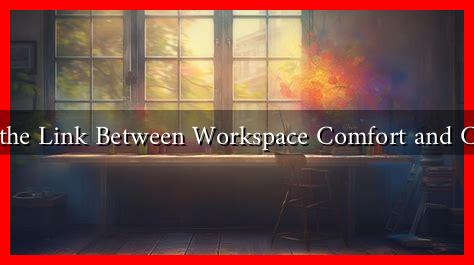-
Table of Contents
What Is the Link Between Workspace Comfort and Creativity?
In today’s fast-paced work environment, the relationship between workspace comfort and creativity has garnered significant attention. As organizations strive to foster innovation, understanding how physical surroundings influence creative output is crucial. This article delves into the intricate connection between workspace comfort and creativity, exploring various factors that contribute to a conducive creative environment.
The Importance of Workspace Comfort
Workspace comfort encompasses various elements, including ergonomics, lighting, temperature, and overall aesthetics. A comfortable workspace can significantly impact employee well-being, productivity, and creativity. Here are some key aspects of workspace comfort:
- Ergonomics: Properly designed furniture and equipment can reduce physical strain, allowing employees to focus on their tasks without discomfort.
- Lighting: Natural light has been shown to enhance mood and energy levels, while poor lighting can lead to fatigue and decreased motivation.
- Temperature: A comfortable temperature range (typically between 68°F and 72°F) can help maintain concentration and prevent distractions.
- Aesthetics: A visually appealing workspace can inspire creativity and foster a positive atmosphere.
The Science Behind Comfort and Creativity
Research has shown that there is a direct correlation between workspace comfort and creative output. A study conducted by the University of Exeter found that employees in well-designed workspaces were 15% more productive than those in poorly designed environments. This increase in productivity can be attributed to several factors:
- Reduced Stress: Comfortable workspaces can lower stress levels, allowing employees to think more freely and creatively.
- Enhanced Collaboration: Open and inviting spaces encourage teamwork and brainstorming, which are essential for creative processes.
- Increased Engagement: Employees who feel comfortable in their environment are more likely to engage in their work, leading to innovative ideas and solutions.
Case Studies: Companies That Get It Right
Several companies have recognized the importance of workspace comfort in fostering creativity. Here are a few notable examples:
- Google: Known for its innovative workspaces, Google incorporates elements like open spaces, relaxation areas, and adjustable furniture to promote comfort and creativity. Their offices are designed to inspire collaboration and out-of-the-box thinking.
- Airbnb: The company’s headquarters features a variety of workspaces, including quiet zones and collaborative areas, allowing employees to choose environments that suit their creative needs.
- WeWork: This co-working space provider emphasizes comfort and aesthetics, offering beautifully designed workspaces that encourage creativity and networking among diverse professionals.
Statistics That Speak Volumes
Several statistics highlight the importance of workspace comfort in enhancing creativity:
- A study by the American Society of Interior Designers found that 90% of employees believe that workplace design impacts their overall job satisfaction.
- According to a survey by Steelcase, 88% of employees reported that their workspace affects their ability to think creatively.
- Research from the University of Warwick indicates that happy employees are 12% more productive, underscoring the link between comfort, well-being, and creativity.
Creating a Comfortable Workspace
Organizations looking to enhance creativity through workspace comfort can implement several strategies:
- Invest in Ergonomic Furniture: Providing adjustable desks and supportive chairs can significantly improve comfort levels.
- Optimize Lighting: Incorporating natural light and adjustable artificial lighting can create a more inviting atmosphere.
- Encourage Personalization: Allowing employees to personalize their workspaces can foster a sense of ownership and comfort.
- Design Collaborative Spaces: Creating areas for teamwork and brainstorming can stimulate creativity and innovation.
Conclusion
The link between workspace comfort and creativity is undeniable. A well-designed, comfortable workspace not only enhances employee well-being but also fosters an environment ripe for innovation. As organizations continue to evolve, prioritizing workspace comfort will be essential for unlocking the creative potential of their teams. By investing in ergonomic furniture, optimizing lighting, and encouraging personalization, companies can create an atmosphere that inspires creativity and drives success.
For further insights on workplace design and its impact on productivity, you can explore resources from the American Society of Interior Designers.


